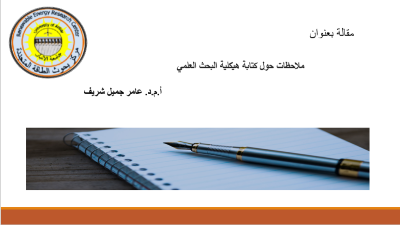| News Details |
Notes about writing the structure of a scientific article
2022-06-29

Assist. Prof. Amer Jamil Sharif
Developed countries realize the importance of scientific research to the extent of their awareness of its role in its continued progress and development, and thus achieve the well-being of their people and preserve their position. Scientific research is the mainstay of economics and development, as it helps to add new information and helps to make new adjustments to previous information to continue its development. The need for scientific research has become more intense in the twenty-first century than ever before, as researchers are racing to the greatest amount of accurate knowledge that provides man with means of comfort and luxury and ensures his superiority over others.
Scientific research is an organized scientific activity and a method of thinking and careful investigation that aims to confirm previous facts or explore new facts based on an objective methodology to identify the interrelationship between these facts and extract the most important results and explanatory laws.
Completing scientific research is one thing, and publishing it in international tanks or high-level journals is another. Publishing research with all its specializations in high-level scientific journals helps to raise the positions of universities to which researchers belong in various scientific and humanitarian disciplines within international universities. Through what has been published in Scopus and the Science Network, a clear weakness of Arab universities appears in catching up with the global pace of scientific publishing and creativity, and the main reason for this may be the lack of financial allocations and support for scientific research.
Knowing how to write scientific research for publication in a scientific journal is not only for beginners researchers and students, as many researchers who submitted previous studies are unable to achieve the required quality in research and are constantly striving to learn how to start writing research and prepare it in the required form to accept its publication in Journals categorized within the international collections, which are the destination of all researchers and the most prominent authority for scientific publishing, which researchers refer to in various fields of their specializations. For the study, certification and intellectual protection of the researcher, and in return, the researcher is required to adhere to the general form of scientific research and the conditions set by these journals. The article gives an introductory guide on how to write research for the symptoms of publication in high-impact journals and the most important conditions and rules imposed by refereed scientific journals with different specializations for publication.
The following are the most important components of writing the structure of scientific research:
1. Title
2. Abstract
3. Keywords
4. Introduction (it also includes previous research)
5. Research methodology (whether theoretical or practical)
6. Results and discussion
7. Conclusions (and recommendations, if any)
8. References
==================================================
1. Title
The title shall be comprehensive and familiar with the idea of ??the research, with the use of words and buzzwords in the subject of the research. In addition to the names of the researchers and the place of work, mentioning the name of the country:

2. Abstract and 3. Keywords
The most important 6 paragraphs for writing a research summary, as shown below. Usually, the research summary and conclusions are written last after completing the research with the final images.

4. Introduction (includes previous research)
First: A paragraph or two that is a general talk about the most important problems, solutions and applications of the idea of the current research: -

Second: The paragraph that follows is a summary of previous and recent research and linking them with each other and does not list a separate account: -

Third: The last paragraph of the introduction is a summary of the current research, as follows:
.jpg)
5. Research methodology (whether theoretical or practical)
Writes according to the subject of the research, whether medically, engineering, humanitarian...etc.
6. Results and discussion
It includes the most important results and percentages of improvement and statistics of the current research, and the comparison between them and the behavior or values of previous research results. It also includes pictures, shapes, tables, charts...etc, according to the topic of the research being studied.
7. Conclusions (and recommendations, if any)

8. References
All references used in the accomplished written research must be recent, and relevant to the topic studied, whether they are research papers, books, websites, master's theses or doctoral theses as needed.
Reference:
1. Khalil, Wissam H., Itimad DJ Azzawi, and Amer Al-damook. "The optimisation of MHD free convection inside porous trapezoidal cavity with the wavy bottom wall using response surface method." International Communications in Heat and Mass Transfer 134 (2022): 106035
2. Azzawi, Itimad DJ, and Amer Al-damook. "Multi-objective optimum design of porous triangular chamber using RSM." International Communications in Heat and Mass Transfer 130 (2022): 105774.
3. Abdulkadhim, Ammar, Hameed K. Hamzah, Farooq Hassan Ali, Ça?atay Y?ld?z, Azher M. Abed, Esam M. Abed, and Müslüm Ar?c?. "Effect of heat generation and heat absorption on natural convection of Cu-water nanofluid in a wavy enclosure under magnetic field." International Communications in Heat and Mass Transfer 120 (2021): 105024.
4. Alomari, Mohammed Azeez, Khaled Al-Farhany, Alaa Liaq Hashem, Mohamed F. Al-Dawody, Fares Redouane, and Olalekan Adebayo Olayemi. "Numerical Study of MHD Natural Convection in Trapezoidal Enclosure Filled With (50% MgO-50% Ag/Water) Hybrid Nanofluid: Heated Sinusoidal from Below." Journal homepage: http://iieta. org/journals/ijht 39, no. 4 (2021): 1271-1279.









